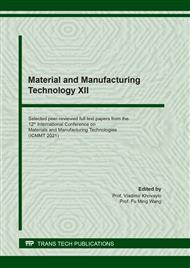[1]
Fuh, Y.K.; Chen, P.C.; Huang, Z.M.; Ho, H.C. Self-powered sensing elements based on direct-write, highly flexible piezoelectric polymeric Nano/microfibers. Nano Energy 2015, 11, 671–677.
DOI: 10.1016/j.nanoen.2014.10.038
Google Scholar
[2]
Wang, X.; Wang, S.; Yang, Y.; Wang, Z.L. Hybridized electromagnetic–triboelectric nanogenerator for scavenging air-flow energy to sustainably power temperature sensors. ACS Nano 2015, 9, 4553–4562.
DOI: 10.1021/acsnano.5b01187
Google Scholar
[3]
Wang, Z.L.; Chen, J.; Lin, L. Progress in triboelectric nanogenerators as a new energy technology and self-powered sensors. Energy Environ. Sci. 2015, 8, 2250–2282.
DOI: 10.1039/c5ee01532d
Google Scholar
[4]
Deitzel J.M, Kleinmeyer J, Harris D and Tan N.C.B 2001 The effect of processing variables on the morphology of electrospun nanofibers and textiles Polymer 42 261.
DOI: 10.1016/s0032-3861(00)00250-0
Google Scholar
[5]
Nasir M, Matsumoto H, Danno T, Minagawa M, Irisawa T, Shioya M and Tanioka A 2006 Control of diameter, morphology, and structure of PVDF nanofiber fabricated by electrospray deposition J. Polym. Sci. Part B Polym. Phys. 44(5) 779.
DOI: 10.1002/polb.20737
Google Scholar
[6]
L. Persano, C. Dagdeviren, Y. Su et al., High performance piezoelectric devices based on aligned arrays of nanofibers of poly (vinylidenefluoride cotrifluoroethylene),, Nature Communications,vol. 4, no. 1, article 2639, (2013).
DOI: 10.1038/ncomms2639
Google Scholar
[7]
Anton, S.R.; Sodano, H.A. A review of power harvesting using piezoelectric materials (2003–2006). Smart Mater. Struct. 2007, 16, R1.
DOI: 10.1088/0964-1726/16/3/r01
Google Scholar
[8]
Mitchell, G.R. Electrospinning; Polymer Chemistry Series; Mitchell, G.R., Ed.; The Royal Society of Chemistry: London, UK, 2015; ISBN 978-1-84973-556-8.
Google Scholar
[9]
M A Zulfikar et al 2018 J. Phys.: Conf. Ser. 987 012011.
Google Scholar
[10]
Zong X, Kim K, Fang D, Ran S, Hsiao B.S and Chu B 2002) Structure and process relationship of electrospun bioabsorbable nanofiber membranes Polymer 43 4403.
DOI: 10.1016/s0032-3861(02)00275-6
Google Scholar
[11]
Theron S.A, Zussman E and Yarin A.L 2004 Experimental investigation of the governing parameters in the electrospinning of polymer solutions Polymer 45 (2017).
DOI: 10.1016/j.polymer.2004.01.024
Google Scholar
[12]
Reneker D.H, Yarin A.L, Fong H and Koombhongse S 2000 Bending instability of electrically charged liquid jets of polymer solutions in electrospinning J. Appl. Phys. 87(9I) 4531.
DOI: 10.1063/1.373532
Google Scholar
[13]
Shao, H.; Fang, J.; Wang, H.; Lin, T. E_ect of electrospinning parameters and polymer concentrations on mechanical-to-electrical energy conversion of randomly-oriented electrospun poly(vinylidene fluoride) nanofiber mats. RSC Adv. 2015, 5, 14345–14350.
DOI: 10.1039/c4ra16360e
Google Scholar
[14]
Matabola, K.P.; Moutloali, R.M. The influence of electrospinning parameters on the morphology and diameter of poly(vinyledene fluoride) nanofibers-E_ect of sodium chloride. J. Mater. Sci. 2013, 48, 5475–5482.
DOI: 10.1007/s10853-013-7341-6
Google Scholar
[15]
Fang, J.; Niu, H.; Wang, H.; Wang, X.; Lin, T. Enhanced mechanical energy harvesting using needleless electrospun poly(vinylidene fluoride) nanofibre webs. Energy Environ. Sci. 2013, 6, 2196–2202.
DOI: 10.1039/c3ee24230g
Google Scholar
[16]
Beachley, V.;Wen, X. E_ect of electrospinning parameters on the nanofiber diameter and length. Mater. Sci.Eng. C 2009, 29, 663–668.
DOI: 10.1016/j.msec.2008.10.037
Google Scholar
[17]
S.-H. Wang, Y. Wan, B. Sun, L.-Z. Liu, and W. Xu, Mechanicaland electrical properties of electrospun PVDF/MWCNT ultrafine fibers using rotating collector,, Nanoscale Research Letters, vol. 9, no. 1, p.522, (2014).
DOI: 10.1186/1556-276x-9-522
Google Scholar
[18]
Alhasssan, Z. A., Burezq, Y. S., Nair, R., & Shehata, N. (2018). Polyvinylidene Difluoride Piezoelectric Electrospun Nanofibers: Review in Synthesis, Fabrication, Characterizations, and Applications. Journal of Nanomaterials, 2018, 1–12.
DOI: 10.1155/2018/8164185
Google Scholar


